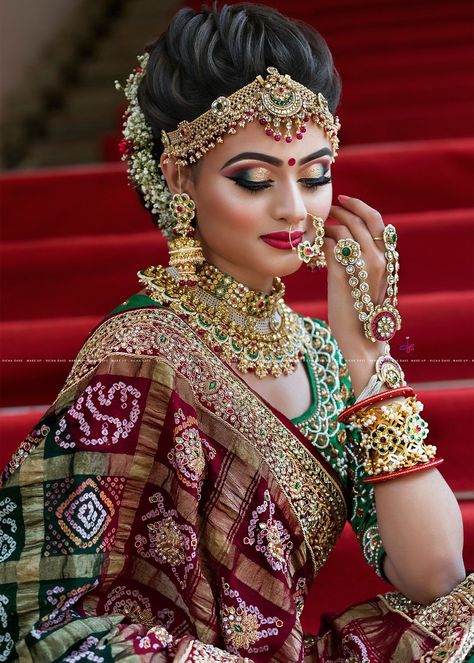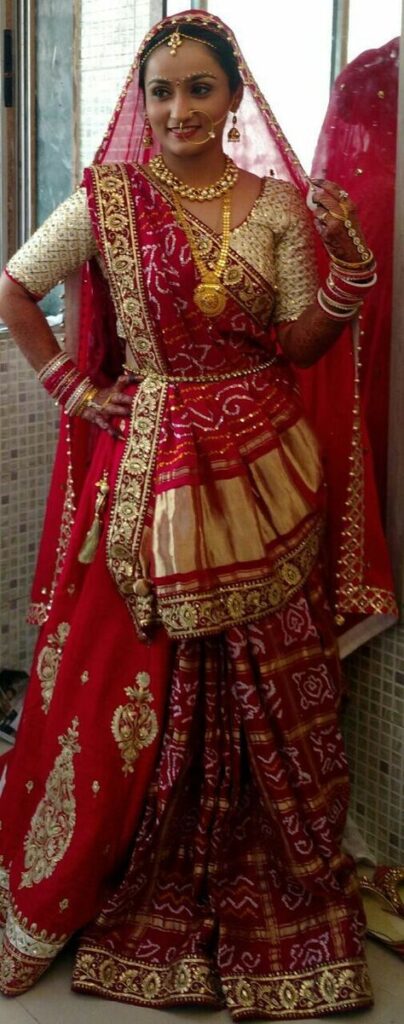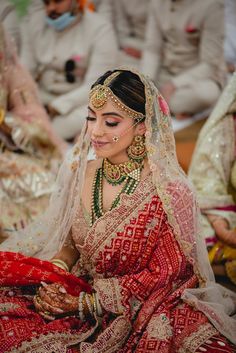Gujrati Bridal
The Gujarati bridal attire is a celebration of color, tradition, and intricate craftsmanship. Nestled in the western region of India, Gujarat is known for its vibrant culture and rich heritage, which is beautifully reflected in its weddings. From the stunning attire to the elaborate rituals, each element of the Gujarati bridal ensemble carries deep cultural significance and symbolism.

Attire: At the heart of the Gujarati bridal attire is the resplendent ‘Panetar’ saree. Typically crafted from fine silk, the Panetar saree is characterized by its pristine white color adorned with intricate red and gold embroidery. The red and white combination symbolizes purity, fertility, and prosperity, making it an integral part of Gujarati weddings.
Accompanying the Panetar saree is the ‘Gharchola’ dupatta, a vibrant piece of attire featuring intricate tie-dye patterns and traditional motifs like elephants, peacocks, and flowers. The Gharchola, usually in shades of red, green, or maroon, symbolizes the bride’s marital status and is draped over the head or shoulders, adding a touch of regal elegance to the bridal ensemble.

Jewelry: No Gujarati bridal look is complete without the dazzling array of traditional jewelry that adorns the bride. From elaborate necklaces to intricately crafted earrings and bangles, each piece of jewelry holds cultural significance and symbolism. The bride wears ‘Chooda,’ a set of ivory bangles adorned with intricate designs, symbolizing marital bliss and prosperity.
The ‘Mangalsutra,’ a sacred necklace made of black beads and gold, is another essential part of the Gujarati bridal jewelry. It symbolizes the eternal bond between the bride and groom and is believed to protect the couple from evil spirits. Additionally, the bride wears a ‘Nath,’ a nose ring adorned with pearls and gemstones, symbolizing beauty and auspiciousness.
Hairstyle and Makeup: The Gujarati bride’s hairstyle and makeup are characterized by simplicity and elegance, enhancing her natural beauty while complementing her bridal attire. Traditional hairstyles like the ‘Mogra bun,’ adorned with fresh jasmine flowers, or the ‘Gajra braid,’ embellished with roses and other blooms, are popular choices among Gujarati brides.

Makeup for the Gujarati bride is understated yet sophisticated, focusing on enhancing her features while maintaining a radiant glow. Soft, earthy tones are often used for eyeshadow and lipstick, complementing the traditional aesthetic of the bridal ensemble.
Accessories: In addition to jewelry, Gujarati brides adorn themselves with a variety of accessories that add to their bridal charm. The ‘Borla,’ a distinctive forehead ornament adorned with pearls and gemstones, is a traditional accessory worn by Gujarati brides. It symbolizes prosperity and marital happiness.
Rituals and Customs: Gujarati weddings are steeped in rituals and customs that add depth and meaning to the celebration. From the pre-wedding rituals like ‘Mangal Snanam’ (auspicious bath) to the post-wedding rituals like ‘Vidaai’ (farewell to the bride), each ceremony is a reflection of Gujarati culture and tradition.
One of the most significant rituals is the ‘Hasta Milap,’ where the bride and groom’s hands are joined, symbolizing their union and commitment to each other. Another important ritual is the ‘Saptapadi,’ where the couple takes seven symbolic steps together, each step representing a vow they make to each other for a harmonious and fulfilling married life.

Conclusion: In conclusion, the Gujarati bridal attire is a beautiful amalgamation of tradition, symbolism, and timeless elegance. From the exquisite Panetar saree to the intricate jewelry and meaningful rituals, each aspect of the Gujarati bridal ensemble embodies the rich cultural heritage of Gujarat. As Gujarati weddings continue to evolve with modern influences, the allure of the traditional bridal attire remains a cherished part of Gujarati culture and identity.


